2014年06月27日
For the Love of Noodles
My cousin recently visited Takamatsu to do an article for an inflight magazine on Sanuki udon, the delicious wheat noodles that have made this area famous throughout Japan. When procured locally, they are not only delicious but incredibly cheap. As we talked udon and ate udon, I wondered what is it that makes these noodles so special?

Piping hot noodles with butter, fresh-ground pepper and egg at Bakaichidai, Takamatsu
Sanuki udon is both the fast food and the comfort food of Kagawa. As this is the driest region of Japan, people traditionally grew wheat, which requires much less water, to supplement the rice crop, and wheat noodles remain a local staple.
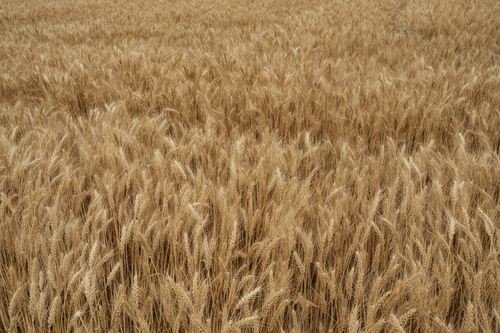
Wheat growing near my house in Takamatsu
Thanks to modern machinery, udon equivalent in texture and taste can now be had not only all over Japan but in other countries as well. While the noodles are good, however, I can testify that something vital is missing.

Udon-making machine in a Sanuki udon shop in Tokyo
Take pride and passion, for instance. Until recently, many Kagawans made udon at home. Traditionally, the firm, silky texture was produced by kneading with the feet.
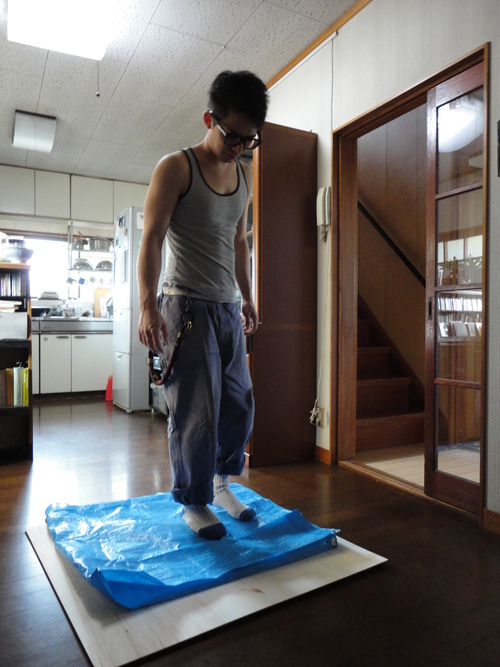
Kneading with the feet at our house
Most shops now have to use machines at least for kneading to keep up with demand, but some still knead, roll and cut by hand (or foot) for customers who come to eat them fresh.

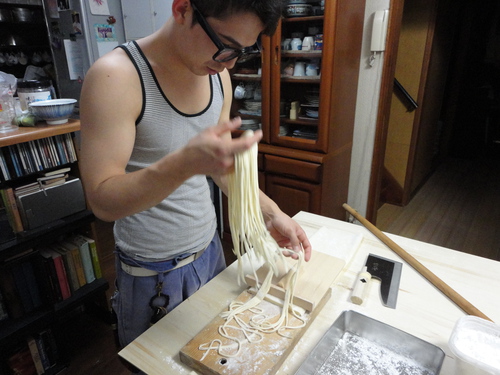
This homemade tradition makes Kagawans connoisseurs. Locals will argue delightedly over which shop has the tastiest noodles, defined by texture, length and thickness, as well as which has the best broth and the greatest toppings and side dishes.
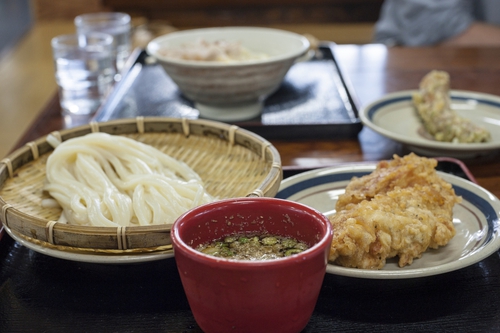
Chilled udon with dipping sauce and sides – Kirin, Takamatsu
That’s another distinguishing feature - diversity. There are over 900 udon shops serving a population of about 1 million, many of whom would willingly eat noodles for breakfast, lunch and dinner. Yet, except for a few chains, the noodles each produces are unique, and this diversity keeps noodle-lovers from getting bored. Every shop has its own carefully guarded recipe for udon and broth, often passed down through the generations, and each is aiming to make the best noodles ever. The taste is imprinted on the tongues of their customers who are quick to note any change.

Udon maestro at Hariya, where impeccable timing ensures perfectly fresh noodles and toppings
Each shop has its own ambience, too. Some are restaurant style, but many deliver most of their noodles to supermarkets, schools, businesses, etc. Those who want to eat in the shop must serve themselves, sometimes even to the point of chopping their own scallions.
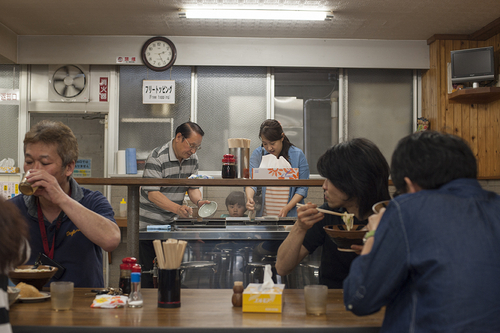
Inside Chikusei, Takamatsu – Customers heat up their own noodles
When noodles set aside for onsite consumption are gone, you’re out of luck, which can happen within 1 to 2 hours. You can tell a popular udon shop by the queue of people hoping to get a bowl before it runs out.

Udon lovers lining up outside Hariya before opening

Lining up inside, too
So what makes Sanuki udon so special? The whole experience. And that, I am afraid, we can’t export so you will just have to come to Takamatsu and experience it for yourself.
(ps. the best photos above are courtesy of Skye Hohmann)
Coming soon!!
Kagawa Waterfront Festival
July 19-August 8 at Sunport. Will include 15-minute hologram shows on a giant water screen in the sea. Come and enjoy art, dynamic historical storytelling, and entertainment. Shows are at 19:40, 20:30 and 21:20 at Sunport. For more details (in Japanese) see: http://www.pref.kagawa.jp/seto80/event/waterfront.html
Sensory Dining in Tamamo Park
Gourmet cuisine served in an exquisite manor house coupled with works produced by top Kagawan artists and artisans make for a special dining experience. http://www.takumikumo.com/shiro-cafe/
For more info on Takamatsu:
http://wikitravel.org/en/Takamatsu
http://www.city.takamatsu.kagawa.jp/english/
http://tia-takamatsu.jp/
http://www.my-kagawa.jp/eg/
Other Takamatsu bloggers:
http://pat.ashita-sanuki.jp/
http://ogijima.com

Piping hot noodles with butter, fresh-ground pepper and egg at Bakaichidai, Takamatsu
Sanuki udon is both the fast food and the comfort food of Kagawa. As this is the driest region of Japan, people traditionally grew wheat, which requires much less water, to supplement the rice crop, and wheat noodles remain a local staple.

Wheat growing near my house in Takamatsu
Thanks to modern machinery, udon equivalent in texture and taste can now be had not only all over Japan but in other countries as well. While the noodles are good, however, I can testify that something vital is missing.
Udon-making machine in a Sanuki udon shop in Tokyo
Take pride and passion, for instance. Until recently, many Kagawans made udon at home. Traditionally, the firm, silky texture was produced by kneading with the feet.
Kneading with the feet at our house
Most shops now have to use machines at least for kneading to keep up with demand, but some still knead, roll and cut by hand (or foot) for customers who come to eat them fresh.
This homemade tradition makes Kagawans connoisseurs. Locals will argue delightedly over which shop has the tastiest noodles, defined by texture, length and thickness, as well as which has the best broth and the greatest toppings and side dishes.

Chilled udon with dipping sauce and sides – Kirin, Takamatsu
That’s another distinguishing feature - diversity. There are over 900 udon shops serving a population of about 1 million, many of whom would willingly eat noodles for breakfast, lunch and dinner. Yet, except for a few chains, the noodles each produces are unique, and this diversity keeps noodle-lovers from getting bored. Every shop has its own carefully guarded recipe for udon and broth, often passed down through the generations, and each is aiming to make the best noodles ever. The taste is imprinted on the tongues of their customers who are quick to note any change.
Udon maestro at Hariya, where impeccable timing ensures perfectly fresh noodles and toppings
Each shop has its own ambience, too. Some are restaurant style, but many deliver most of their noodles to supermarkets, schools, businesses, etc. Those who want to eat in the shop must serve themselves, sometimes even to the point of chopping their own scallions.

Inside Chikusei, Takamatsu – Customers heat up their own noodles
When noodles set aside for onsite consumption are gone, you’re out of luck, which can happen within 1 to 2 hours. You can tell a popular udon shop by the queue of people hoping to get a bowl before it runs out.
Udon lovers lining up outside Hariya before opening
Lining up inside, too
So what makes Sanuki udon so special? The whole experience. And that, I am afraid, we can’t export so you will just have to come to Takamatsu and experience it for yourself.
(ps. the best photos above are courtesy of Skye Hohmann)
Coming soon!!
Kagawa Waterfront Festival
July 19-August 8 at Sunport. Will include 15-minute hologram shows on a giant water screen in the sea. Come and enjoy art, dynamic historical storytelling, and entertainment. Shows are at 19:40, 20:30 and 21:20 at Sunport. For more details (in Japanese) see: http://www.pref.kagawa.jp/seto80/event/waterfront.html
Sensory Dining in Tamamo Park
Gourmet cuisine served in an exquisite manor house coupled with works produced by top Kagawan artists and artisans make for a special dining experience. http://www.takumikumo.com/shiro-cafe/
For more info on Takamatsu:
http://wikitravel.org/en/Takamatsu
http://www.city.takamatsu.kagawa.jp/english/
http://tia-takamatsu.jp/
http://www.my-kagawa.jp/eg/
Other Takamatsu bloggers:
http://pat.ashita-sanuki.jp/
http://ogijima.com
My Profile
Cathy Hirano キャシー ヒラノ
I've lived in Japan since 1978. After graduating from a Japanese university with a BA in cultural anthropology in 1983, I worked as a translator in a Japanese consulting engineering firm in Tokyo for several years. My Japanese husband and I moved to Takamatsu in 1987 to raise our two children in a slower-paced environment away from the big city pressures. We've never regretted it. I work as a freelance translator and interpreter and am involved in a lot of community work, including volunteering for Second Hand, a local NGO that supports educational and vocational training initiatives in Cambodia, and for the Takamatsu International Association. I love living in Takamatsu.
Cathy Hirano キャシー ヒラノ
I've lived in Japan since 1978. After graduating from a Japanese university with a BA in cultural anthropology in 1983, I worked as a translator in a Japanese consulting engineering firm in Tokyo for several years. My Japanese husband and I moved to Takamatsu in 1987 to raise our two children in a slower-paced environment away from the big city pressures. We've never regretted it. I work as a freelance translator and interpreter and am involved in a lot of community work, including volunteering for Second Hand, a local NGO that supports educational and vocational training initiatives in Cambodia, and for the Takamatsu International Association. I love living in Takamatsu.
Posted by cathy at 11:06│Comments(0)
※会員のみコメントを受け付けております、ログインが必要です。





